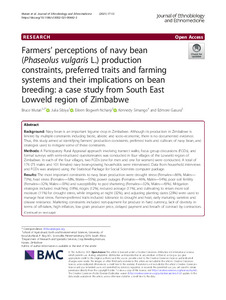Farmers’ perceptions of navy bean (Phaseolus vulgaris L.) production constraints, preferred traits and farming systems and their implications on bean breeding: a case study from South East Lowveld region of Zimbabwe
Abstract
Background
Navy bean is an important legume crop in Zimbabwe. Although its production in Zimbabwe is limited by multiple constraints including biotic, abiotic and socio-economic, there is no documented evidence. Thus, this study aimed at identifying farmers’ production constraints, preferred traits and cultivars of navy bean, and strategies used to mitigate some of these constraints.
Methods
A Participatory Rural Appraisal approach involving transect walks, focus group discussions (FGDs), and formal surveys with semi-structured questionnaires was conducted in four villages of the Lowveld region of Zimbabwe. In each of the four villages, two FGDs (one for men and one for women) were conducted. A total of 176 (75 males and 101 females) navy bean-growing households were interviewed. Data from household interviews and FGDs was analysed using the Statistical Package for Social Scientists computer package.
Results
The most important constraints to navy bean production were drought stress (Females—86%, Males—73%), heat stress (Females—58%, Males—55%), power outages (Females—46%, Males—54%), poor soil fertility (Females—32%; Males—33%) and susceptibility to pod shattering (Females—32%, Males—43%). Mitigation strategies included mulching (18%), ridges (12%), reduced acreage (11%), and cultivating to retain more soil moisture (11%) for drought stress, while irrigating at night (32%), and adjusting planting dates (29%) were used to manage heat stress. Farmer-preferred traits included tolerance to drought and heat, early maturing varieties and disease resistance. Marketing constraints included non-payment for produce in hard currency, lack of diversity in terms of off-takers, high inflation, low grain producer price, delayed payment and breach of contract by contractors.
Conclusion
There will be increased adoption of improved navy bean cultivars if breeding programs address the aforementioned constraints and consider farmer-preferred traits when developing new cultivars. Breeders should work closely with extension officers to ensure that cultivars released are cultivated with appropriate agronomic packages for increased productivity and high adoption.

